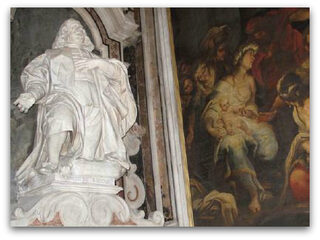
- Chapel of St. Anna, detail
The church was built in 1595 with a single aisle and five chapels on each side and between 1633 and 1639 was extended by adding the transept, the apse and the dome. The façade, decorated with rococo stucco works, was redesigned in 1769-70 by Bartolomeo Vecchione. The church is hung with paintings by important and prestigious Neapolitan painters of the 17th century: Annella de Rosa, who painted the canvases in the presbytery representing the Birth and Death of the Virgin; Battistello Caracciolo, painter of the Trinitas terrestris in the third chapel on the right; Filippo Vitale, who painted the Guardian Angel in the fifth chapel on the left; Belisario Corenzio, who painted the panel of the Annunciation in the third chapel on the left.
Apart from these, there is a Deposition from the Cross by Luca Giordano and a Resurrection of Christ by Paolo de Matteis. In the large chapel on the right dedicated to S. Anna, there are canvases by Andrea Vaccaro and Giacomo Farelli. The annexed college had a poor-house school whose pupils wore dark blue cassock, and it is after this colour that the church is named, since "turchino" means "dark blue". Some of the pupils of this school were Alessandro Scarlatti, Gian Battista Pergolesi and Giovanni Paisiello.
In 1808 this poor-house school was merged with others in the ex-convent of S. Sebastiano, and then in 1826 became part of the convent of S. Pietro a Maiella.